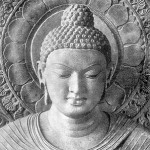Spiritual Support
 Why meditate? Why pray, or participate in a pilgrimage, or live alone for a year in the woods? Sometimes it’s because you are at your wit’s end, and sometimes you just need help.
Why meditate? Why pray, or participate in a pilgrimage, or live alone for a year in the woods? Sometimes it’s because you are at your wit’s end, and sometimes you just need help.
Jack Kornfield, who co-founded the large western Vipassana Buddhist practice center in Barre, Massachusetts, once said that when the center opened in the late 70’s, their focus was on the first Noble Truth, that ‘In life, there is suffering;’ in other words, bringing clarity to the pervasiveness of suffering until one can’t stand it anymore and must make a change. In the Buddha’s view, even pleasant things pass away and so spiritual life must push beyond both pain and pleasure. “But,” Kornfeld added, “We were young and had a lot of energy then.”
I find deep suffering in my life and the lives of others, also. I find the ‘marks’ of the conditions of life: It’s transience, the lack of permanent definition, and I find dissatisfaction. These truths have inspired me to practice, to sit alone with reality and to sit together with others in spiritual pursuit. As a person who is growing older, I also appreciate more and more the third and fourth Noble Truths of there being a way for suffering to cease, and the path of its cessation.
I also forget. I am carried by habits of avoidance, distraction, ignorance, weariness, anxiety, selfishness, fear, envy, anger and on and on. I become blinded to the fact that I am the only thing standing between myself and liberation. I forget the fire that once burned in me to open up, no matter what, to the truth of life.
So it is a two-fold question that I ask myself. What influences or helps me to practice, and to practice deeply and correctly? I’d like to offer four things that may be helpful, hopeful, and peaceful in motivating, continuing, or deepening practice.
- Teachers. When I go to sit with a teacher who has dedicated a significant portion of their life to practice, I hear the words of the Buddha come alive. Usually, meditation instruction is included, so being with a teacher is good practice in and of itself. One hears so many ideas from so many people about life and what to believe in. The television and internet are telling us to believe in acquisition and material satisfaction. It’s nice to spend time with someone who embodies the spiritual side of things. It’s inspiring, like “Wait, he’s a human being and I’m a human being, so therefore…..” Being near a teacher, even for an hour, is supportive and offers a refuge.
- Relaxation. This seems to be a theme among contemporary teachers. Perhaps it was always there, but it really applies to our stressed out lifestyle. I don’t think it’s a lethargic thing at all, just a positive way of letting go of stress in the body and mind so that one can concentrate or practice insight meditation. While calm is one result of concentration on an object, it’s a good admonition as well. Sometimes I ask myself “Where am I tightly wound?” in body or thinking, then I can relax a little, stop feeding into the tightness, practice some acceptance, which clears the way for paying attention.
- Letting go. Have you experienced under times of great stress a sense of something much greater and more important and liberating? Not that we should forget the importance of tasks, meetings, celebrations, operations, and the like, but I think the Buddha would ask us if our attitude toward the events of life is leading us toward liberation or just getting us more wrapped up. He said: “Whatever is not yours: let go of it. “ None of it, within or without is ‘ours’. The Buddha said that it is very hard to let go of the mind because it is sort of composed of holding on. Training the mind in concentration helps to clarify this useless process so that we can let go of it.
- Dealing with fear. I notice fear in letting go. I feel like I am losing myself. Even in breathing meditation there are a lot of ways to recreate my own world, like “I am breathing” and “I am experiencing a clear mind” and so on. Then when I get closer to just the breath I can feel my definitions slip away and it is uncomfortable, it is scary. Thanissaro Bhikkhu suggests to : “Have good will toward your breathing, compassion, appreciation, equanimity towards your breathing. In other words, allow the breath to be comfortable so that you can have a foundation. Where it’s not comfortable, work at making it more comfortable: That’s compassion. Where it is comfortable, appreciate it.” Fear is underneath a lot of negative emotions. It is difficult to stay put for a while and gain the confidence and objectivity needed to work kindly with fear.
The Buddha emphasized the help that a Sangha can give. He said: “The Sangha of the Blessed One’s disciples: worthy of gifts, worthy of hospitality, worthy of offerings, worthy of respect, the unexcelled field of merit for the world. . . when you have recollected the Sangha, whatever fear, terror, or horripilation is will be abandoned.”
It seems that the spiritual journey has a quality of not turning back, and therefore of leaving much that is held on to behind. It is good to go forward with the help of others, and with kindness in our efforts.
So, wishing you good practice from Boston (or is it Antarctica, I can’t tell anymore), and peace. Missing everyone.
James Reis




